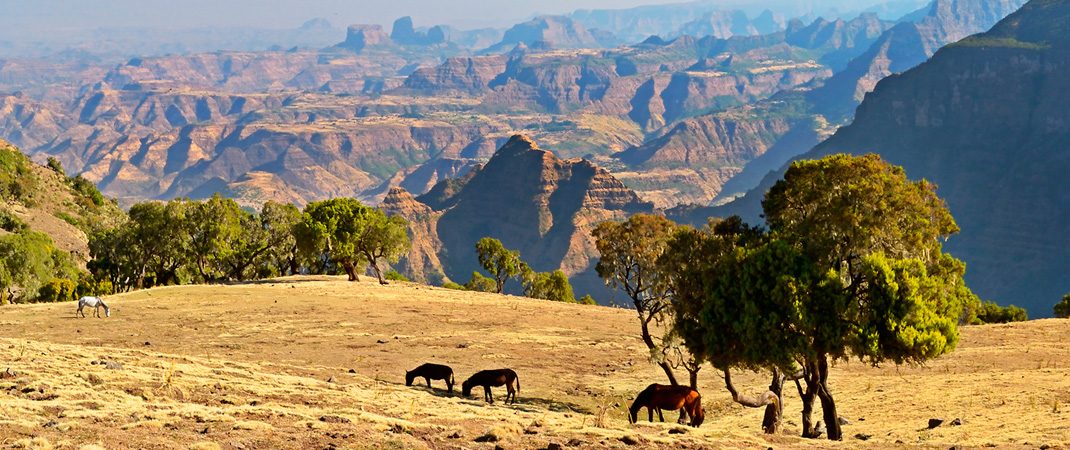Ethiopia is not everyone’s first choice for a holiday vacation in Africa but is well worth visiting as it is very different from neighbouring countries. The Simien Mountains surrounding the country are arguably the most spectacular mountain range in Africa and are an excellent place for a trekking holiday. The famed historic route is a well-trodden route for visitors including Lalibela with its 13th century rock-hewn churches, Bahir Dar with the nearby Tississat Falls (also known as Blue Nile Falls) and Lake Tana, Gondar with its medieval castle and Axum, the alleged resting place of the Ark of the Covenant. In the south of Ethiopia is the famed Omo Valley with a multitude of different tribes. In the east is Harar which is considered the 4th most holy city by muslims.
The people have a distinctive appearance, partly like their neighbours in the Middle East and partly like the rest of Africa. However, some 50% are Christian and the influence of the church is considerable. Ethiopia has its own written language, Amharic, and traditions in literature, dress, dance and music have flourished in the relative isolation provided by their mountainous territory.
Attractions and Ancient Cities
Major attractions are the ancient cities of Gondar, Axum and Harar, and these have all retained the atmosphere of their historical backgrounds. There are some extraordinary churches hewn from rock in Lalibela. The Historic Route (Bahar Dar, Gondar, Axum, Lalibela, Addis Ababa) is becoming popular with visitors and there are daily flights between the cities.
Wild Life and Bird Life Tours
Ethiopia has some fine wildlife, and all the major animals of Africa, except for rhinoceros are present in the selection of relatively small but delightful parks scattered across the country. The birds are a particular attraction.
MAJOR PLACES OF INTEREST IN ETHIOPIA
Aksum (Axum)
Some 365 km northeast of Gondar lies the town of Axum, site of Ethiopia’s oldest city. Axum dates back some 2000 years to when it was the hub of the Axumite Empire and the capital of one of the four world powers. The half-buried ruins of palaces and fortresses make Axum one of Ethiopia’s most important historical sites, and ongoing archaeological excavations and discoveries will help increase our understanding of its importance in the ancient world. The Queen of Sheba (called Makada in Ethiopia) made it her capital 1000 years before Christ.
Evidence of past glories include huge monolithic granite obelisks or stelae (pillars), some fallen and some still perpendicular, grouped together in the northeast of the town. Made of single blocks of granite, the tallest stood over 33 m high and weighs approximately 500 tonnes and is the largest monolith in the world. The 4 sides of this pillar are highly decorated and represent the front of a 12-storey building.
Gondar
Some 50 km north of Lake Tana, 748 km north of Addis Ababa and nestling in the foothills of the Simien Mountains, the ancient city of Gondar is undoubtedly one of the most thrilling experiences that Ethiopia has to offer, with its churches, castles and mountain scenery.
Gondar was the capital of Ethiopia from the rise of Fasilades (1632-1635) until the fall of Tewodros (1855-1868), a status that is reflected in the many castles and palaces that grace the city. At first sight, the architecture seems to reflect Moorish-European influence and, indeed, the presence of the Portuguese in the 16th century may have influenced the design of some of the fortresses, but closer inspection reveals a continuity with the Axumite tradition.
Harar
Harar is a walled city of 123,000 people within the Oromiya Region, standing on the eastern wall of the Great Rift Valley, 526 km from Addis Ababa. A major trading centre with India and the Middle East, it was designated as a UNESCO World Heritage Site in 2006. The city’s lofty situation gives wonderful views of the surrounding country – the vast Danakil desert to the north, the fertile mountains to the east and the cattle-rich Ogaden plains to the south. The whole town is surrounded by soaring mountains and fanned by cool, bracing air. Hara was a fiercely religious city from the early days of Islamic expansion into the Horn of Africa when it was a ‘forbidden city’ (closed to visitors), until 1887 when Menelik forced it into the Ethiopian Empire. The women of Hara are reputed to be the most beautiful in Africa, and Hara itself is famed for its silversmiths, with exquisite necklaces, bracelets and chains to be found in the market.
Lalibella
Lalibela, a UNESCO World Heritage Site 640 km from Addis Ababa, was built as the capital of a local king following the fall of Axum, and it became the centre of religious authority in Ethiopia. According to legend, in the 12th century Prince Lalibela, of the Zagwe Dynasty, was drugged by his brother the king, who feared he would be overthrown. During his drugged sleep angels brought him to heaven, where God instructed him to return home and build churches of a unique style. His brother later abdicated and Lalibela was crowned king. He gathered an army of craftsmen, who carved out the cliff face at Roha, fashioning 11 churches.
Lalibela consists of 6 churches to the north and five churches to the south of the Jordan River. The churches are linked by a series of hewn chancels and tunnels, similar to catacombs. Starting at the eastern cluster of churches, Bieta Medhane Alem is the largest rock-hewn church in the world, almost 800 sq m in area. The interior is reminiscent of cathedral. From the courtyard outside a tunnel leads to another courtyard which has another three churches. The most imposing of these is Bieta Maryam dedicated to the Virgin Mary. It is much more ornately decorated, with the Star of David and the Lalibela Cross. A third courtyard grants access to another two churches, where the remains of the King of Lalibela are rumoured to be buried.




Leave a Reply